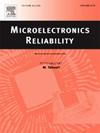Accelerated lifetime estimation and failure analysis of micromachined humidity sensors under high temperature and high humidity conditions
IF 1.9
4区 工程技术
Q3 ENGINEERING, ELECTRICAL & ELECTRONIC
引用次数: 0
Abstract
Accelerated Life Testing (ALT) is used to detect and understand failure mechanisms, as well as to calculate and evaluate the robustness and resulting reliability of electronic components such as sensors subjected to various influencing factors in different applications. Based on the successful lab and field robustness validation of the customized Humidity Sensor in Axle Bearings (HSAB) system utilized for the condition monitoring of lubricated rail components, an ALT methodology was designed for a micromachined humidity sensor, and respective results are presented. ALT was aimed at quantifying the robustness of the selected sensor under higher-than-normal use environmental loads (temperature and humidity), with a focus on its sensor element. Thus, ALTs under constant high temperatures combined with low- and high-humidity conditions were executed until all the tested sensor elements failed. Thereafter, the resulting failures were investigated using various methods. The solder joint failure of the sensor element was determined as a central failure mode. Based on the data obtained for the time to failure of the sensor elements, a two-parameter Weibull distribution function was fitted, in agreement with comparable scientific works on solder joint failures. As the aged sensor elements themselves did not seem to be significantly influenced or even damaged by the executed ALTs, their existing functionality was proven afterwards. For this purpose, they were first resoldered and then tested using a developed step-validation test program for temperature and humidity. After a statistical evaluation of the sensor signal deviations relative to a calibrated reference sensor, the amount of still operational sensor elements was assessed. As a result, it was determined that sensor elements aged at high temperatures in a high-humidity atmosphere failed to a significantly greater extent owing to the damaging effect of water. This indicates that water significantly affected not only the solder joints of the sensor but also the sensor element itself under the investigated test conditions.
高温高湿条件下微机械湿度传感器加速寿命估算及失效分析
加速寿命试验(ALT)用于检测和了解失效机制,以及计算和评估电子元件(如传感器)在不同应用中受到各种影响因素的鲁棒性和由此产生的可靠性。基于用于润滑轨道部件状态监测的定制轴轴承湿度传感器(HSAB)系统成功的实验室和现场鲁棒性验证,设计了用于微机械湿度传感器的ALT方法,并给出了相应的结果。ALT旨在量化所选传感器在高于正常使用环境负载(温度和湿度)下的鲁棒性,重点是其传感器元件。因此,在恒定的高温结合低湿度和高湿度条件下执行alt,直到所有被测试的传感器元件失效。此后,使用各种方法对导致的失效进行了调查。将传感器元件的焊点失效确定为中心失效模式。根据所获得的传感器元件失效时间数据,拟合了一个双参数威布尔分布函数,与可比较的有关焊点失效的科学工作相一致。由于老化的传感器元件本身似乎没有受到执行的alt的明显影响甚至损坏,因此它们的现有功能后来得到了证明。为此,首先对它们进行重新排序,然后使用开发的温度和湿度步进验证测试程序进行测试。在对相对于校准参考传感器的传感器信号偏差进行统计评估后,评估了仍在运行的传感器元件的数量。结果表明,由于水的破坏作用,传感器元件在高温、高湿环境下老化失效的程度要大得多。这表明,在研究的测试条件下,水不仅显著影响传感器的焊点,而且显著影响传感器元件本身。
本文章由计算机程序翻译,如有差异,请以英文原文为准。
求助全文
约1分钟内获得全文
求助全文
来源期刊

Microelectronics Reliability
工程技术-工程:电子与电气
CiteScore
3.30
自引率
12.50%
发文量
342
审稿时长
68 days
期刊介绍:
Microelectronics Reliability, is dedicated to disseminating the latest research results and related information on the reliability of microelectronic devices, circuits and systems, from materials, process and manufacturing, to design, testing and operation. The coverage of the journal includes the following topics: measurement, understanding and analysis; evaluation and prediction; modelling and simulation; methodologies and mitigation. Papers which combine reliability with other important areas of microelectronics engineering, such as design, fabrication, integration, testing, and field operation will also be welcome, and practical papers reporting case studies in the field and specific application domains are particularly encouraged.
Most accepted papers will be published as Research Papers, describing significant advances and completed work. Papers reviewing important developing topics of general interest may be accepted for publication as Review Papers. Urgent communications of a more preliminary nature and short reports on completed practical work of current interest may be considered for publication as Research Notes. All contributions are subject to peer review by leading experts in the field.
 求助内容:
求助内容: 应助结果提醒方式:
应助结果提醒方式:


